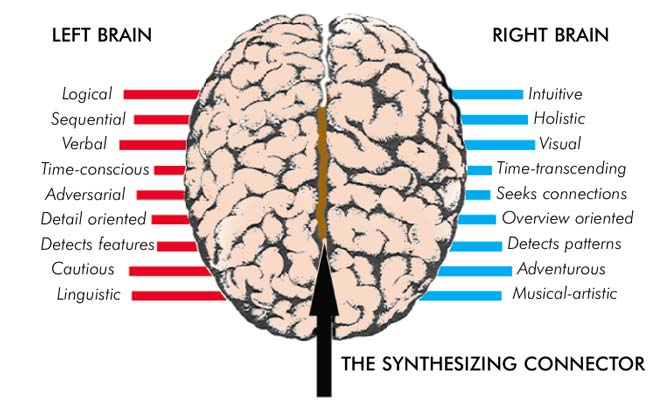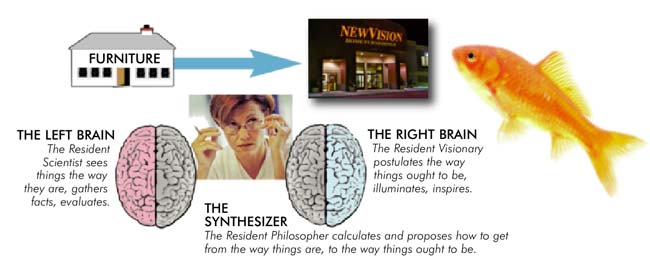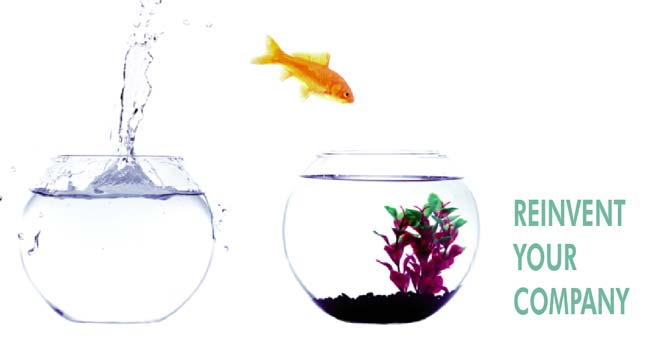Why should you reinvent your company? Of course, you don’t have to. But, as Steve Chandler, author of Wealth Warrior, points out: “Companies and individuals who reinvent themselves are more prosperous than those who stay stuck where they are.”
The situation today is something like the plot from the movie, “The Edge.” A billionaire and two employees are lost in the Alaskan wilds. His two associates panic, and the billionaire stays calm. He asks one of them, “Do you know why most people who become lost in the wilderness die?” The employee answers, “No, why do they die?” The billionaire answers: “They die of shame. They believe that they are to blame for their predicament. They feel guilt and shame. They fail to do the one thing that could save them. They fail to think.” To survive, the billionaire reinvents himself. To reinvent himself he thinks on a deeper level than he ever had before. The other two guys don’t change, and they consequently perish.
Likewise, many independent furniture entrepreneurs are in trouble, not only because of the awful economy, but because they fail to think and effectively respond to the challenges they face. Or, perhaps I should say they fail to think in a fresh, bold, creative and strategic way. That’s what it takes to reinvent your store, your associates, and yes, yourself. Thinking purely tactically is like a coach going into a football game without a game plan. He may have lots of great plays, but these are tactics. The tactical entrepreneur goes aimlessly from sale to sale. Tactics are important, but without a dynamic game plan, tactics cannot be employed with maximum effectiveness. Also, unless the team players understand and buy into the game plan, there will be a minimum of effective teamwork.
YOUR MYSTERIOUS THINKING MACHINE
You were born with the most prodigious data processor known to humankind, the human brain. Unfortunately, you were not given comprehensive training nor even an operator’s manual on how to use it. For this reason, very few people benefit from even a fraction of their brain’s capacity. In fact, even though we rely upon our brain constantly, no one has a clue about how it works. If I were to ask you your telephone number, you would respond easily. However, if I were to ask you what looked for that number, where it found the number, and how it delivered that number to your conscious mind, you would be at a loss to answer me. Nor can science answer those questions. I cannot either, but I can tell you a great deal about how to use your brain in a creative, strategic way.

The objective of this article is to offer you the basic principles of a new way of thinking, MetaThink™. Without exaggeration, this could be the most important survival information you will acquire in this age of retail uncertainty and challenge. I will explain how to make this creative process work so effectively that you will astound those competitors who now underestimate you.
The MetaThink process begins with the knowledge that you have “two brains.”
THE MYSTERY OF YOUR DUAL BRAINS
The human brain seems to have been designed for MetaThinking.
The left hemisphere of the brain is generally acknowledged as the seat of logical, pragmatic, fact-oriented thinking. It is very time-conscious; it’s the word-oriented center of our speech, and can be a wonderful servant in analyzing material reality. The other side of the brain, the right hemisphere, is the seat of creative thinking. It is intuitive, conceptual, and unbound by time. We might say that the left brain is our “resident scientist” who can examine our business and accurately report the way things are. The right brain is our “resident visionary,” and can imagine a better business, a business with associates who serve and delight customers with awesome efficiency–the way things ought to be.

The two points of view, the logical and the intuitive, are synthesized by the passage of billions of messages back and forth each second between the brain’s two hemispheres. Our task is to oversee this synthesizing process. Here is another way of saying all of this: the left hemisphere gathers information and provides the material fact of what is; the right hemisphere conceptualizes a vision of what could be. There is obviously a gap between what is and what ought to be, and we evaluate the meaning of this gap by synthesizing the two perspectives. Ideally, we should then strive to take action and close this gap.
It is upon the vast loom that exists between what is and what should be that we weave our destiny, using the threads of today’s thoughts and actions. And, it is in this realm of choice where our will can assert its relative creative freedom. The author, John Steinbeck, once wrote that he was “split into three people” during the creative process because he sensed he was being engaged in a three-dimensional adventure. Likewise, when you are involved in deep thinking about your business or any major problem or important goal, you may sense that you are also getting information from three sources. Most modern business persons tend to see things in one dimension. Perhaps they are materialists who principally think in terms of material reality - what is. Or they may be dreamers, who essentially think in terms of what ought to be, and who are not well-grounded in material reality. Or, worst of all, they may be stuck in the dead center of indecision. Many business people simply can’t make up their minds.
Traditionally, the materialist took pride in power, and the visionary reminded him to temper power with compassion. But now things happen too fast. The voice of the visionary is too often ignored. What the world needs now are leaders who are MetaThinkers, men and women who can synthesize the practical with the ideal. These are the creators who make things happen, the shakers and the movers. The furniture industry has a measure of these people, but it needs more.
THE SHORTEST ROUTE TO RETAIL SUCCESS
Don’t try to imitate the Big Boxes. You throw away the pivotal advantages you have when you attempt this. MetaThink insists we think for ourselves, that we challenge the broad assumptions of both those who presume to tell us the way things are and those who fancy that they know the way things ought to be. It is rough when you are besieged by huge Big Box advertising budgets, tough customers, and a foundering economy to simply pause, stop, and think. Just as it is difficult when lost in the wilderness to take a deep breath and calmly ponder the situation. Even so, while the scrutiny process seems to take time at first, it is not down time. MetaThinking eventually saves time and is the shortest route to retail success.

So, exactly what is the practical application for MetaThink? How can you put this theory to work for you to create a strategy for a more prosperous and profitable store, and support it with vibrant tactics? You can set the reinvention process into motion in three broad areas. All three are difficult in that they challenge you to leave your comfort zone. However, once the three steps are completed, everything else becomes much easier. Everything you do will be exponentially more effective. I will list them briefly below. But make no mistake, I appreciate the fact that home furnishings retailing is one of the most complex activities of commerce. A home furnishings entrepreneur is required to wear a dozen or so hats: buyer, display designer, manager, psychologist, salesperson, marketing director, and on and on. What I am about to propose will be quite a ride, and you will likely want to sacrifice many sacred cows along the way. Here are the three wide-ranging areas of the reinvention process:
Create a compelling vision. Where do you want to be this time next year? In sales, market share, profit and team-building? Freeing your right brain to create a vision as you think about these issues is a good starting point. But only a starting point; much more needs to be done to completely define and energize your vision with tactical innovations.
Communicate your vision to all of your associates. Tell them what you want to achieve. Explain what steps you are going to personally take to get there and, what tactics you personally will employ to make your store a better place to work by this time next year. Here your left brain must play a dominant role. By documenting your vision, communicating and committing to it openly, you have increased its power immensely.
Get associate feedback. Ask them what they will individually contribute to have a better store next year. Find out what they need from management to achieve their goals. With this step, a mutual commitment has been formulated, and a bond of teamwork has been formed. Done correctly, everyone will be on the same page and dedicated to the same victorious strategic goal.
THE DEVIL IS IN THE DETAILS
When you take all three steps and they are working together, you will take a quantum leap past competition, including, and perhaps especially, big box competition.
In this series I will explain exactly how to take each step. The first step is to establish the game plan; your strategic vision. You may believe you have one already. But the odds are it is a vague idea that no one else in your company knows much about. When Fortune 500 CEOs were asked if they had a clearly defined vision and a mission for their companies, over 90% replied that they did. However, when their top managers were asked the same question, the percentage fell to the seventies. When middle managers and supervisors were asked, the percentage who knew the mission fell to the forties. And when line personnel were asked, it actually fell to the teens! When we finish this MetaThinking strategic process, not only will you have a clearly defined and articulated vision, but virtually every one of your associates will appreciate it and will buy into it.
We live in a left-brain dominated, materialistic world. Very few people understand the life-altering significance of maintaining a vision. Walt Disney achieved the creative successes he did because he understood this principle. Disney said he always used “six humans and one accountant” on every creative team. By this, he meant he engaged six right-brain, creative visionaries and one materially-grounded left-brainer for every project. Disney knew that, although the appropriate amount of left-brain practical insight will help keep the task financially and materially on track, a little practicality goes a long way. Left brainers tend to aggressively dominate teams, and they must be outnumbered or the team effort may grind to a halt.
TAKING ACTION
Our action-objective now is to start the conscious cultivation of your creative power in new and positive ways. Begin to capture the visions of your right brain. Set aside a time––perhaps a half hour––every day to spend with your muse, your resident visionary. She is always anxious to provide good ideas, and occasionally great visions. We are usually too busy, too occupied with problems and concerns to listen. During this half hour, you are stepping into the “eye of the hurricane,” where there is always total calm. Surely no one has ever been confronted with greater burdens than George Washington during the dark days of the Revolutionary War. He would give orders that he was not to be disturbed at certain times and this is when he renewed his inner strength. Set aside a half hour tomorrow to begin the process of consulting with your resident visionary. During this period, strive to think in pictures, not words.
Capture these creative ideas by commanding your left brain to record them in writing. Carry a small notebook to record creative ideas when they come through at odd times during the day. Cultivate this new partnership with your resident visionary. Even the most wonderful concept has no temporal power until it finds a human channel to manifest it. Until then, it is but a potential. Your daring vision will simply fade into oblivion if you do not act upon it. The first step is to record it. Then begin to embellish it. Once you have recorded your idea, begin to develop an action plan. In the next article, we will take the visualization process to another level. Having a magnificent data processor––the human brain––and knowing something about how it works is important, but not enough.
Rather than another year of the same-old, same-old, why not address some of the issues that you continually avoid yet you know are killing business? In this series I will focus on the five most common problems I encounter from independent retailers.
- No authentic game plan, no broad strategy, only endless advertising tactics that are no longer working the way they once did.
- The most common complaint is the cost of advertising.
- Weak traffic and difficult, suspicious customers.
- Low employee morale.
- Loss of market share.
In our next article we will formulate a specific game plan to address your specific needs. Then we will learn how one furniture retailer developed a remarkable method to sell his team on his game plan. He told me that he wanted to create a “different kind of company.” He was so good at doing this that over the next decade he grew from a single market to one of the largest home furnishings chains in America. He added the caveat that very few CEOs could use his formula, because few would go to the efforts he took to create a fresh vision each year and sell it to his associates. Indeed, I have learned over the years that he was right. Superlative leadership and dedication to serving customers on the level this great retailer achieved are indeed infrequent in any industry. I cannot reveal his name, but if you are open to the idea of reinventing your company, in this series of articles, I will tell you exactly how he did it.
Larry Mullins is a contributing editor for Furniture World and has 30+ years of experience on the front lines of furniture marketing. Larry’s mainstream executive experience, his creative work with promotion specialists, and mastery of advertising principles have established him as one of the foremost experts in furniture marketing. His affordable High-Impact programs produce legendary results for everything from cash raising events to profitable exit strategies. His newest books, THE METAVALUES BREAKTHROUGH and IMMATURE PEOPLE WITH POWER… How to Handle Them have recently been released by Morgan James Publishing. Joe Girard, “The World’s Greatest Salesman” said of this book: “If I had read Larry Mullins’ book when I started out, I would have reached the top much sooner than I did.” Larry is founder and CEO of UltraSales, Inc. and can be reached directly at 904.794.9212 or at Larrym@furninfo.com. See more articles by Larry at www.furninfo.com or www.ultrasales.com.